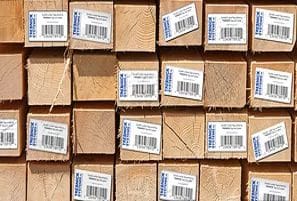All About Lumber Tags for Barcode and RFID Tracking of Wood Products
In the lumber business (production, treatment, distribution, and retail), accurate product identification is critical. Yet lumber isn’t like boxes or pallets—it’s a rough, outdoor product often exposed to weather, chemicals, and heavy handling. That’s why standard barcode labels just don’t survive. Instead, companies rely on lumber tags—durable barcode labels engineered specifically for wood products.
The RFID and barcode label and tag experts at CSSI can help you with specification and testing of lumber tags. Contact us to discuss lumber tags.

What Are Lumber Tags?
Lumber tags are rugged barcode labels made to attach directly to boards or bundled lumber for tracking and identification. These tags carry product data like:
- Species (e.g., Douglas Fir, Pine)
- Dimensions (e.g., 2×6, 4×4)
- Grade
- Moisture content
- Batch or mill number
- Treatment info (e.g., pressure-treated or kiln dried)
- Inventory or SKU data
Depending on the application, lumber tags can be stapled to the end of a board, tied to a bundle, or applied using a specialty adhesive designed for wood surfaces.
For scanning lumber tags, you will want to choose a rugged mobile computer such as the Zebra MC9400 which is built to withstand outdoor use and challenges such as temperature and moisture.
Who Uses Lumber Tags?
Lumber tags are useful at all levels of the wood supply chain:
| Industry User | Purpose |
|---|---|
| Sawmills & lumber mills | Identify species, batch, and grade during production |
| Planing mills | Track dimensions and finishing stages |
| Wood treatment facilities | Verify treated vs. untreated lumber |
| Wholesale lumber distributors | Manage large inventory across multiple yards |
| Building material retailers (Home Depot, Menards, builders) | Use barcodes for pricing and inventory |
| Exporters/importers | Support traceability documentation |
| Custom millwork shops | Track small-batch specialty wood |
Why Are Lumber Tags Used?
Lumber tags solve several challenges unique to wood handling and tracking:
✅ Accurate Inventory Control
Tracking by barcode eliminates costly product mix-ups—especially when multiple species and sizes look similar.
✅ Traceability & Compliance
Thanks to regulations like the Lacey Act and FSC chain-of-custody requirements, it’s important to trace lumber back to its source.
✅ Faster Workflows
Scanning barcode tags is much faster than manually recording product details when loading trucks or staging inventory.
✅ Support for Automation
Modern lumber yards are increasingly using scanners, handheld computers, and even RFID systems to move quickly and reduce errors.
Why Not Use Standard Barcode Labels?
It may be tempting to try standard barcode labels, like the ones used on shipping boxes—but those labels simply don’t survive in lumber environments. Rough lumber surfaces can result in paper label tears. Moisture & humidity ruin legibility. Stains and preservatives break down tag adhesives. Outdoor storage enables UV light to fade printing.
Tags must be capable of surviving for weeks or even months without losing legibility or falling off, which means that the use of standard labels and tags is not advisable.
Special Materials & Adhesives for Lumber Tags
Lumber tags are made with industrial-grade materials like HDPE, UV-resistant vinyl, or synthetic stock that is both waterproof and tear-resistant. They’re built to handle temperature extremes, rain/humidity, sun exposure, chemicals, and difficult/rough attachment surfaces. Lumber tags use resin-based printing, which won’t smear or fade outdoors like standard thermal labels.
Types of Lumber Tags
| Type | Best Use |
|---|---|
| Staple-on tags | Individual boards |
| Bundle tags | Banding or strapping for lumber packs |
| End grain tags | Applied to the sawn edge of boards |
| Adhesive lumber labels | For smooth or planed lumber |
| RFID-enabled tags | Advanced traceability and automation |
Popular Barcode Symbologies Used for Lumber
One of the decisions which you need to make when implementing lumber tags is the specific barcode format (symbology) to be used. Here are the primary common choices:
| Barcode Type | Why It’s Used in Lumber Operations |
|---|---|
| Code 128 | Most common—compact, supports long alphanumeric strings like mill codes, dimensions, and grade info. |
| Interleaved 2 of 5 (ITF-14) | Used for bundle tracking and carton codes; scans well in dirty/outdoor environments. |
| UPC-A / EAN-13 | Required when selling to big-box retailers like Home Depot, Lowe’s, or Menards. |
| QR Codes | Used for tracking digital certificates (FSC, PEFC) and compliance documents. |
| DataMatrix | Small footprint for small or cut pieces; used less commonly. |
| RFID EPC Gen2 | Enables wireless scanning of full lumber bundles without line of sight. |
Let’s Discuss Lumber Tags for Your Wood Industry Operation
CSSI works with a broad range of tag and label suppliers. We have access to special products suitable for lumber, including RFID and barcode tags and labels. We can help you select and test tag products to ensure reliability for your operation. Please contact our consumable media team to discuss options.
